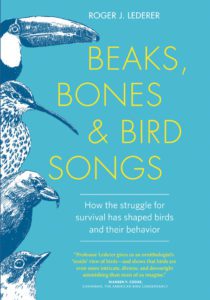Book review: Beaks Bones & Bird Songs

Beaks, Bones & Bird Songs: How the Struggle for Survival Has Shaped Birds and Their Behavior
by Roger J. Lederer (2016, Timber Press, 280 pp., $24.95)
As most folks know, I am an avid birdwatcher. I love watching them, photographing them and landscaping to attract them. I’ve also discovered that a large percentage of the gardeners I connect with are crazy about birds, too.
Most of us know the basics about birds, but there are so many intriguing facts we should all be aware of. Fortunately, there’s a book for that! In Beaks, Bones & Bird Songs, author Roger Lederer shares with us important details of how birds interact with each other. And with the world around them. He also explains how they’ve adapted over time based on environmental challenges. Lederer also includes how we humans impact them on a daily basis. It makes for fascinating reading.
We can trust Lederer to know what he’s talking about. For 40 years, he taught courses in ornithology and ecology, has published six books on birds and numerous scientific papers. He’s also the founder of the authoritative website, Ornithology.com.
The author begins with an interesting discussion of how birds have evolved based on the types of food they eat. These are seeds and grains, insects, fruits, nectar, fish, meat and so on.
He then examines how birds use their senses to survive in this world. It was fascinating reading how young quail will communicate with their parents while still in the egg. This includes when the eggs need turning and with coordinating when to hatch with their unhatched siblings.
I also learned how some birds use their sense of smell to find food, locate their mates or to save themselves from predators.
I particularly enjoyed the chapter on flight, since that is the ability we all admire in our feathered friends. Think about how we frequently see geese flying in a “V” formation. Did you know they are essentially drafting behind each other, just like cyclists do? It helps them save energy? And that they take turns leading?
The chapter on migration was also intriguing. In it, I learned that Arctic terns fly 300 to 400 miles per day (!) during their migrations. Some birds flying as much as 66,000 miles in a year. That is mindboggling. Lederer covers the tools birds use to find their destinations, including landmarks, the sun and stars, geomagnetic forces, smells, and sounds we can’t hear.
Throughout the book, the author introduces the reader to terms they might not be familiar with –and defines them for us — and cites applicable studies to back up the information he shares. While a book of references to scientific studies might be considered a cure for insomnia, the author does a great job of keeping us enthralled with information on these amazing creatures.
Another topic that has amazed me over the years is how birds deal with extreme heat and cold while we humans take advantage of air conditioning and woodstoves, as needed. I read how birds regulate their heat during winter through the addition of body fat, shivering, huddling, various postures, and — in some birds — through torpor in which their body temperatures drop dramatically during nighttime.
In Lederer’s chapter on how birds live together, he discusses the niches birds live within based on what part of the ecosystem they inhabit, different species’ territories and predation.
The final chapter, “What We Do To Birds,” is sobering. Between climate change, habitat destruction, power lines or glass windows that birds crash into, and predation by cats, it’s a wonder there are birds left on this planet. The author shares information on how some species have adapted to some of the challenges along with interesting solutions to help them out.
Lederer sums it up like this:
“Too often there is a disconnect between the natural world of birds and other organisms and our technology-obsessed everyday life. Birdwatching connects people to the environment and helps them understand why birds need protection from human activities. And the more we understand birds, the more we understand the environment from which they come and which they depend upon for survival, and the more likely we are to be able to protect them.”

